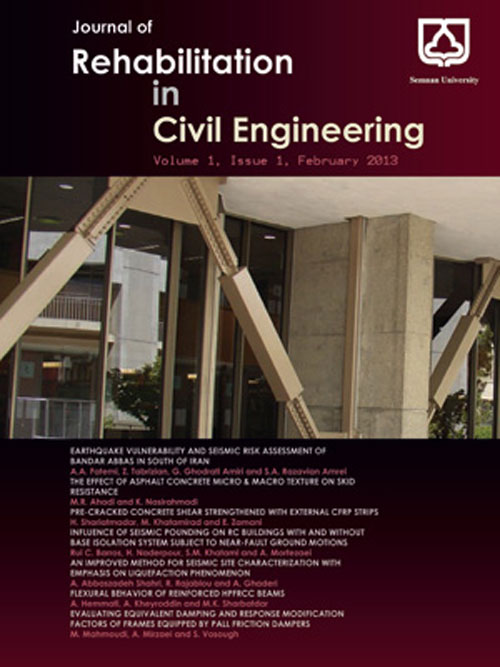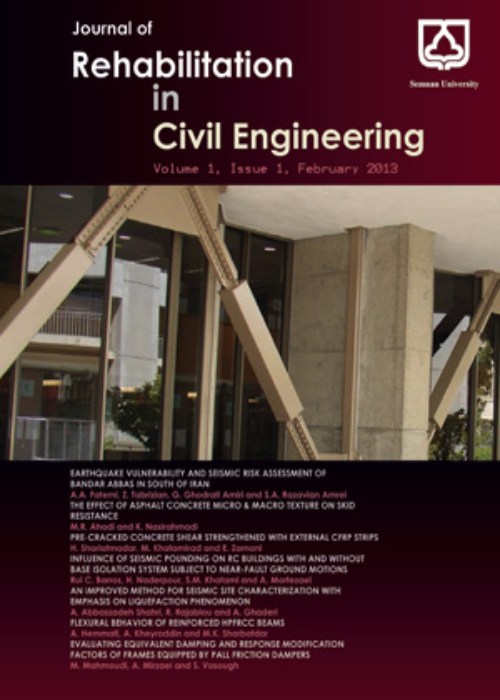فهرست مطالب

Journal of Rehabilitation in Civil Engineering
Volume:6 Issue: 1, Winter-Spring 2018
- تاریخ انتشار: 1397/02/30
- تعداد عناوین: 10
-
-
Pages 1-9Weirs, as overflow structures, are extensively used for the measurement of flow, its diversion and control in the open canals. Labyrinth weir due to more effective length than conventional weirs, allows passing more discharge in narrow canals. Determination the design criteria for the practical application of these weirs need more investigation. Weir angle and its position relative to the flow direction are the most effective parameters on the discharge coefficient. In this study, Fluent software was used as a virtual laboratory and extensive experiments were carried out to investigate the effect of geometry on the labyrinth weir discharge coefficient. The variables were the height of weir, the angle of the weir and the discharge. The discharge coefficients obtained from these experiments were then compared with the corresponding values obtained from the usual rectangular sharp crested weir experiments. Comparison of the results showed that in all cases with different vertex angle, flow discharge coefficients are in a satisfactory range for relative effective head less than 0.3. The discharge coefficient is decreased for relative effective head more than 0.3 due to the collision of water napes. It showed the higher weir, the more discharge capacity. As a result, the labyrinth weirs have a better performance in comparison with the common sharp crested.Keywords: Labyrinth weir, Discharge Coefficient, Computational fluid dynamics, Fluent
-
Pages 10-22Asphalt mixture is heterogeneous in nature; therefore, macroscopic parameters alone cannot describe the mechanical behavior of the mixture. In recent years, the arrangement of the aggregate particles in terms of spatial and directional distributions, and contact points are considered as the internal structure of asphalt. The main purpose of this paper is to investigate the microstructural characteristics of asphalt cores using 2-D images. Comparison between the internal structure features in the laboratory samples and the Field samples is shown in this paper. The results show that the survey of microstructural characteristics of asphalt cores by image processing provides new and useful information. This finding indicates that the number of contact points in cores is close to the lab samples that have been made at 45 to 65 blows on each end of the sample.Keywords: Aggregate particles, Internal structure, Core samples, Contact points
-
Pages 23-36Most of oil and gas offshore platforms are located in the seismic regains. So, Seismic vulnerability evaluation of the offshore platforms is one of the most important and vital issues in the structural systems. In this study, jacket type offshore platforms are studied by incorporating the pushover analyses and nonlinear time history analyses, in such a way that, first some push over analyses are performed to detect the more critical members of the jacket platform according to the range of their plastic deformations. Then, nonlinear time history analyses are performed, concentrating on the critical members, to investigate the vulnerability of the jacket platform under intensive earthquake loads. Based on the numerical results, the combination of the push over analyses and nonlinear time history analyses presents a reliable and swift seismic assessment procedure to estimate the seismic vulnerability of the offshore platforms. Moreover, seismic vulnerability of the offshore structures is dependent on the critical member locations and their load bearing situations in the offshore structures.Keywords: Jacket offshore platform, Nonlinear time history analysis, seismic assessment, Pushover analysis
-
Pages 36-50In many cases, a set of obstacles, such as bridge piers and abutments, are located in the river waterway. Bridge piers disrupt rivers normal flow, and the created turbulence and disturbance causes diversion of flow lines and creates rotational flow. Geometric shape and position of the piers with respect to flow direction and also number of piers and their spacing are effective on changing the river-flow conditions, such as formation of vortices, their breakdown and hydrodynamic forces exerted on the piers. This study has been performed by using the two-dimensional, open-source, OpenFOAM software. After selecting the grid size in GAMBIT software, different pier shapes were investigated, taking into account different Reynolds numbers, and formation of the flow pattern, Strouhal number, vortex magnitude, and drag and lift coefficients for each pier shape were specified. Results for three different pier shapes showed that in Reynolds number of 200, the highest drag coefficient (1.82) and maximum flow velocity (1.55 m/s) was related to square pier. The lowest drag coefficient (0.46) was calculated for the rectangular pier (having a semi-circular edge on one side and a sharp-nose edge on the other side) when the flow collides with the semi-circular edge. The least drag and lift forces are exerted to the rectangular pier, as compared to other pier shapes. The lowest lift coefficient (0.012) was obtained for rectangular pier. On the other hand, position of sharp-nose edge in the wake region caused the vortex shedding to occur at a greater distance from the pier.Keywords: Bridge piers, abutments, Flow pattern, Drag, lift forces, Vortex shedding, Wake region, OpenFOAM
-
Pages 51-59Corrosion of steel is one of the most important potential dangers and threats in concrete structures. Corrosion of steel embedded in reinforced concrete plays a key role in reducing the strength and durability of reinforced concrete. Several studies have proposed that alternative approaches to enhancing the performance of reinforced concrete and its resistance to corrosion. In this study, the results of steel corrosion embedded in reinforced concrete with silica fume and Nano-silica particles are presented. For testing, samples with a mixture of these particles ranging from 0 to 133 grams were generated and their performance was compared using Corrosion Potential (OCP), Electrochemical Impedance Spectroscopy (EIS), Linear Polarization (LPR), and TOEFL polarization tests. The results demonstrate that silica fume is effective in reducing permeability of the concrete against malicious (adverse) ions, but nano-silica had far satisfying performance in reducing the corrosion rate of steel embedded in concrete.Keywords: Reinforced concrete, Steel corrosion, Nano, silica, Silica fume, Electrochemical tests
-
Pages 60-71The incident angle of ground motion is one of the sources of uncertainty in the seismic response of buildings. Moreover, understanding the structural response to the impose ground motion may cause significant changes in the maximum response of buildings. In order to investigate the effect of the spatial distribution of orthogonal components of earthquake strong motion on the structural responses, three 15-story buildings is analyzed in this study using time history method. A significant live load (750 kg/m2) is imposed at different vertical levels of the structures. The imposed load was combined with ground motion excitations in the range of 0 to 90 degrees. The response of structure was investigated using roof drift index and inter-story drift ratio. Results demonstrate orientation of seismic excitation and considering the maximum values of roof drift index which correspond to the critical direction increase roof drift index between 8 to 12 percent. Furthermore, the inter-story drift ratio increased between 30 to 33 percent due to orientation of excitation and considering the maximum values of inter-story drift ratio which correspond to the critical direction.Keywords: Directionality, Concrete 3D frame, Mid, rise, irregularity, Incident angle
-
Pages 70-87
This paper presents a robust hybrid improved dolphin echolocation and ant colony optimization algorithm (IDEACO) for optimization of truss structures with discrete sizing variables. The dolphin echolocation (DE) is inspired by the navigation and hunting behavior of dolphins. An improved version of dolphin echolocation (IDE), as the main engine, is proposed and uses the positive attributes of ant colony optimization (ACO) to increase the efficiency of the IDE. Here, ACO is employed to improved precision of the global optimization solution. In the proposed hybrid optimization method, the balance between exploration and exploitation process was a main factor to control the performance of the algorithm. IDEACO algorithm performance is tested on several problems of benchmarks discrete truss structure optimization. The results indicate the excellent performance of the proposed algorithm in optimum design and rate of convergence in comparison with other meta heuristic optimization methods, so IDEACO offers a good degree of competitiveness against other meta heuristic methods.
Keywords: Hybrid optimization algorithm, Meta heuristic, Discrete variables, Dolphin echolocation -
Pages 88-103This paper provide an artificial neural network model for prediction the shear contribution of FRP in reinforced concrete (RC) beams strengthened in shear with externally bonded FRP. Although there are some models and equations for estimating the contribution of FRP, these models in some cases have significant error in calculation of FRP contribution. One of reasons for these errors is neglecting the effect of shear span (a) to effective depth of beam (d) ratio in FRP performance. In this model mechanical and dimensional properties of RC beams strengthened and strengthening materials and also the shear span to effective depth of beam ratio (a/d) are taken as input parameters and the shear contribution of FRP is the target of the network. After a comprehensive review in existing literature, 96 strengthened RC beams which all of them have FRP rupture failure mode were selected which 92 of them were used for training, validation and testing the network and four of them were used for controlling the generalization of network. Finally the outputs of model have compared with ACI 440.2R, fib 14 and CIDAR guidelines and the result indicated that the ANN model is more accurate than the existing guideline equations based on experimental result.Keywords: RC beams, Shear, FRP bond, ANN
-
Pages 104-115
Leak has always been one of the problems in water distribution networks, whose preventing not only results in saving of water sources, but also has profound effects on maintenance cost of networks. In present paper, a new method is applied for leak detection in water collection and transmission network. In this method, detection of leak location is performed by pressure difference analysis at junctions and by the help of relative index of leak. In this regard, at least two nodes have to be selected for pressure measurement within the network, in order to monitor the pressure changes in with and without leak cases. The investigated network in this research includes 7 wells with approximate length of 7800 m located in North Western city of Mashhad. A real leak with a rate of 7.57 l/s is created at one of the network nodes whose amount is measurable by a volume counter. Finally, this leak is identified by the proposed method via 3 nodal pressure measurements
Keywords: Leak detection, Nodal pressure, Water conveyance system, Head loss, Leak index -
Pages 116-131
The chloride corrosion of reinforcing steel in reinforced concrete (RC) structures is a significant reason for premature deterioration and failure of RC structures in aggressive environments such as Persian Gulf region. This is one of the most important sources of engineering and economic problems in developed countries. So, the repair and maintenance of RC structures exposed to corrosive environments are very important for optimizing the service life and life cycle cost of these structures. In this research, a finite element model is applied to assess the time-dependent capacity of corroded RC structures using nonlinear analysis; this includes the impact of corrosion on inelastic buckling and low-cycle fatigue degradation of reinforcements. In this analysis, the influence of a number of repair or rehabilitation methods on the performance of a corroded square RC column due to chloride-induced corrosion are investigated and compared, including concrete surface coatings used on the external surface of concrete, and shotcrete repair after the initial cracking of concrete cover. So that, to investigate the surface coating influence on the corrosion percentage of reinforcements and structural performance due to corrosion, two surface coatings as repair methods are simulated as the equivalent concrete cover thickness. The equivalent concrete cover thickness is considered on the initial concrete cover at crack initiation time that decreases the corrosion current density and corrosion percentage after this time. Moreover, the equivalent concrete cover thickness is calculated based on experimental data of chloride diffusion into concrete specimens with surface coating located in south of Iran.
Keywords: Repair, Corrosion, Reinforced Concrete Column, Shotcrete, Surface coating


